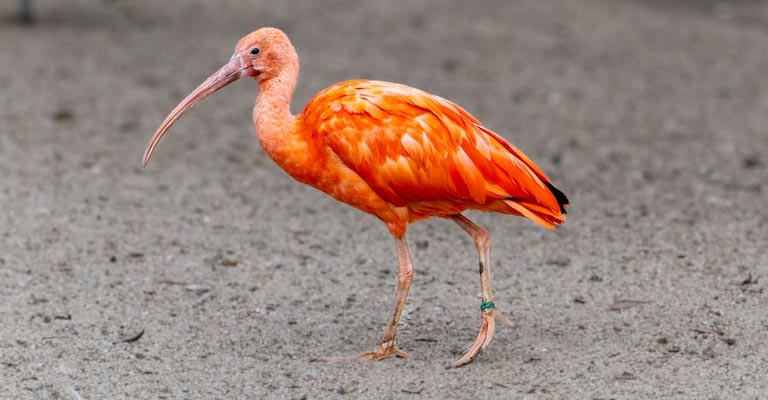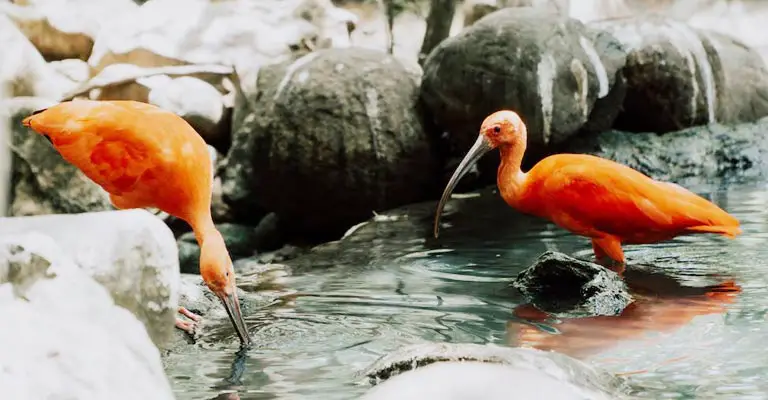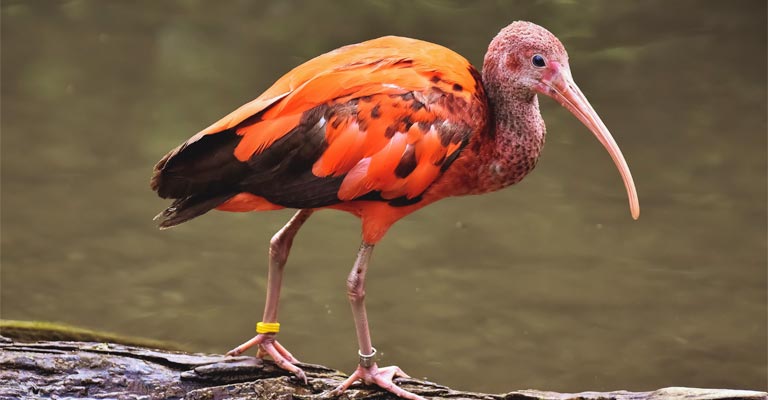The scarlet ibis, a mesmerizing bird known for its vivid crimson plumage, inhabits the lush coastal regions of South America and the Caribbean. This stunning avian species has captured the fascination of naturalists and bird enthusiasts alike.
However, beyond its visual splendor, the scarlet ibis has a deeply intertwined relationship with its environment, one that is vital for its very survival. In this exploration, we delve into ‘how is the environment important to the Scarlet Ibis’ survival’.
From the rich wetlands to the salty marshes, the scarlet ibis has evolved unique strategies and behaviors to adapt to its surroundings, relying on the environment’s resources for sustenance, shelter, and safety.
Understanding the significance of the environment to the scarlet ibis’s survival not only highlights the intricate web of life on our planet but also underscores the pressing need for conservation efforts to protect these magnificent creatures and the ecosystems they call home.

How Is the Environment Important to The Scarlet Ibis’ Survival?
The Scarlet Ibis is primarily found in mangroves, mudflats, coastal wetlands, and lagoons of tropical South America and the Caribbean. These habitats are teeming with life, providing an abundant source of food for the ibis.
The bird’s choice of location for breeding and foraging is not arbitrary; it is a testament to the close relationship it shares with its environment.
Diet and Foraging
The Scarlet Ibis’s diet is diverse and depends largely on the habitat it resides in. Its main food sources include crabs, shrimps, insects, and small fish.
The ibis employs its long, slender bill to probe the mudflats and shallow waters, capturing prey with remarkable precision. The health of the environment directly impacts the availability of these food sources.
In nutrient-rich environments like mangroves, the ibis finds an abundance of crustaceans and other aquatic creatures.
The interplay between tides, nutrient cycles, and the presence of various life forms in these habitats ensures a steady supply of food. Environmental changes that affect these processes can have a profound impact on the ibis’s food availability.
Nesting and Reproduction
Scarlet Ibis breeding season is a spectacle to behold. The ibises gather in large colonies to nest, often in the same mangrove trees year after year.
The choice of nesting location is influenced by factors such as isolation from predators, availability of food, and the presence of other ibises. These factors are inextricably linked to the environment.
The interconnectedness of the ibis’s environment plays a critical role in its reproductive success. Changes in the environment, such as habitat destruction or pollution, can disrupt nesting sites and affect the survival of chicks.
Social Structure and Behavior

Scarlet Ibis is known for its social behavior. They often form large flocks, which can consist of hundreds or even thousands of individuals. These flocks serve multiple purposes, including protection from predators and efficient foraging.
The ibis’s social structure and behavior are closely tied to the availability of resources in their environment. When food is abundant, they can gather in larger flocks.
However, if their environment becomes degraded or food sources decline, it can lead to a breakdown in their social structure and a decrease in their population.
Threats to Survival
The Scarlet Ibis faces various threats that are fundamentally rooted in environmental challenges. Habitat loss due to urban development, agriculture, and deforestation is one of the primary concerns.
These activities encroach on the ibis’s natural habitats, limiting their access to critical resources and nesting sites.
Pollution is another significant threat. Runoff from agricultural chemicals and industrial pollutants can contaminate the waters where the ibis forage for food. This contamination not only impacts the ibis but also the entire ecosystem.
Climate change is altering the landscape and ecology of the ibis’s habitat. Rising sea levels, extreme weather events, and changing temperature patterns can disrupt the delicate balance of the coastal ecosystems, impacting the ibis’s food sources and nesting sites.
Additionally, human activities such as hunting and egg collection have been detrimental to the Scarlet Ibis population in the past. Conservation efforts have been instrumental in reducing these threats, but continued vigilance is necessary.
Conservation Efforts
Conservation initiatives are vital to safeguarding the Scarlet Ibis and its environment. Many organizations are working to protect the bird’s habitat, raise awareness about its importance, and monitor its population.
Efforts to preserve and restore mangroves and wetlands are crucial, as these are the ibis’s primary habitats. Legislation and regulations have been enacted to curb habitat destruction and protect critical nesting sites.
Educational programs and ecotourism provide an opportunity for local communities to understand the value of the ibis and its habitat. When people appreciate the importance of these ecosystems, they are more likely to support conservation efforts.
The Bigger Picture
The Scarlet Ibis’s story is a microcosm of the broader environmental challenges we face. The interdependence between this remarkable bird and its habitat highlights the delicate balance of nature.
Human activities have the potential to disrupt this balance, threatening not only the ibis but countless other species and ecosystems.
What Are the Physical Characteristics of The Scarlet Ibis?

The most defining feature of the Scarlet Ibis is its striking plumage, which is the vivid, deep scarlet color that sets it apart from other Ibis species.
The brilliant scarlet hue of the feathers is a result of the bird’s diet, rich in carotenoid pigments found in its favorite prey, such as crustaceans and insects.
As the pigments accumulate in their feathers, they take on the remarkable crimson shade that captivates bird enthusiasts and naturalists alike.
Size and Body Structure
The Scarlet Ibis is a medium-sized bird with a distinctive body shape. They typically measure around 55-63 cm (22-25 inches) in length and have a wingspan of about 86-92 cm (34-36 inches).
Their body structure is characterized by a long, slender neck and legs, and a slightly curved, slender bill that is specially adapted for their feeding habits.
Bill Structure: A Precision Tool
The ibis’s long, slender bill is a remarkable adaptation for its foraging behavior. This bill is used to probe into mudflats and shallow waters to capture its prey with pinpoint accuracy. The bill is typically black and contrasts beautifully with the bird’s scarlet plumage.
Facial Features: Striking Blue Eyes
The Scarlet Ibis boasts captivating blue eyes that create a vivid contrast with its scarlet feathers.
The eyes are encircled by a narrow, featherless patch of skin, which enhances the striking effect. This unique facial feature adds to the bird’s allure and has captured the attention of many admirers.
Legs and Feet: Slender and Graceful
The legs and feet of the Scarlet Ibis are long, slender, and a pale pink to scarlet color. These features not only contribute to its graceful appearance but are also well-suited for wading through the shallow waters and mudflats where the ibis find their food.
Its long legs enable it to navigate these watery habitats while its delicate, webbed feet assist in walking on soft surfaces.
Wing Structure: Functional Beauty
The wings of the Scarlet Ibis are not as vibrant as its plumage but are still an essential part of its physical makeup. When in flight, the dark-colored wings contrast with the scarlet body, creating a captivating sight.
The wings are strong and well-suited for long-distance flights, and the ibis uses them to travel between its feeding and nesting areas.
Sexual Dimorphism: Minimal Differences
Unlike some bird species, the Scarlet Ibis exhibits minimal sexual dimorphism. Both males and females share the same striking scarlet plumage and similar physical characteristics.
This makes it challenging to differentiate between the sexes based solely on appearance. Instead, behavioral cues and vocalizations are often used to distinguish between males and females during the breeding season.
Molting: Renewal of Colors
The vibrancy of the Scarlet Ibis’s plumage is not constant throughout the year. Like many other birds, the ibis undergoes molting, during which old feathers are shed, and new ones grow.
During the molting process, their feathers may temporarily lose some of their intense coloration, appearing paler or even white. However, with time, the fresh feathers regain their brilliant scarlet hue, and the ibis returns to its iconic appearance.
Adaptations for Feeding
The Scarlet Ibis’s physical features are beautifully adapted to its feeding habits. Its slender bill is designed for probing into soft mud and water, allowing it to pick out prey hidden beneath the surface.
The long legs and webbed feet assist in wading through the shallow waters and mudflats where it finds its primary food sources. Its precision in capturing prey in its bill demonstrates the remarkable adaptation this bird has developed for its unique way of life.
FAQs
What is the significance of the Scarlet Ibis’s vibrant plumage?
The striking scarlet plumage of the Scarlet Ibis is significant for several reasons. It’s primarily a result of the bird’s diet, which is rich in carotenoid pigments found in its prey.
How does the Scarlet Ibis obtain its food?
The Scarlet Ibis is a wader, which means it forages for food in shallow waters and mudflats. It uses its long, slender bill to probe into the substrate, capturing prey such as crustaceans, shrimps, insects, and small fish.
Where can the Scarlet Ibis be found in the wild?
The natural range of the Scarlet Ibis includes the coastal regions of South America and the Caribbean. They inhabit areas like mangroves, mudflats, coastal wetlands, and lagoons.
Is the Scarlet Ibis endangered or threatened?
The Scarlet Ibis has faced habitat loss and threats due to human activities, such as deforestation and pollution. Conservation efforts have been put in place to protect their habitats and control hunting.
How do Scarlet Ibises behave during the breeding season?
During the breeding season, Scarlet Ibises exhibit social behavior and gather in large colonies. They often return to the same nesting sites year after year. The choice of nesting location is influenced by factors such as isolation from predators.
Conclusion
The environment is not just important to the survival of the scarlet ibis; it is its lifeline. This stunning bird’s reliance on its habitat is a testament to the delicate balance of nature, where every element plays a crucial role in the survival of a species.
The scarlet ibis, with its vibrant plumage and graceful presence, serves as a vivid reminder of the interconnectedness of all life on Earth.
As we study the scarlet ibis and its environmental dependencies, we are reminded of the urgent need to conserve and protect these ecosystems.
Human activities and climate change threaten the habitats that the scarlet ibis and countless other species rely upon.
By safeguarding the environments that sustain such remarkable creatures, we ensure that the scarlet ibis and its incredible story continue to thrive, adding to the rich tapestry of life on our planet.